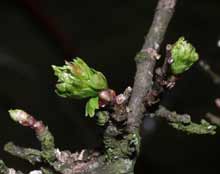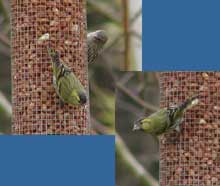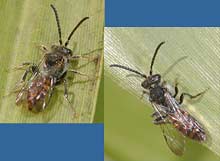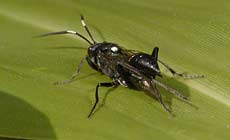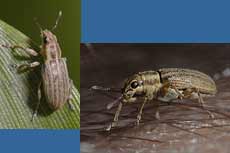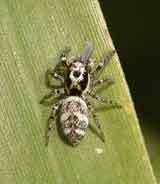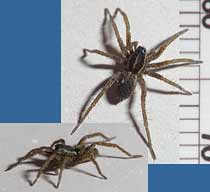Go to last entry of the month.....................Go to previous entry16 March - What a change in the weather! Today it is sunny, breezy and the temperature outside at 2.30pm is nearly 17C! Earlier, Sheila and I had coffee down the bottom of the garden in the area we now call 'The West Wing' (as it is at the western end of the garden), and I suspect we will be eating there again this afternoon.
As if to the celebrate the arrival of this warm spell, the first Lesser Cellandine flower has opened in the border - the first of many that will appear in the next month or so.
Also, the first bug sighting of the year. This one was floundering on the pond surface, but I though it should be recorded here rather than in the pond diary. Measuring around 4mm in length, I think it may be a Common Flower Bug (Anthocoris nemorum) which is a predator of aphids and red spider mites.
On the bird front things continue to be extremely quiet, with just the House Sparrows, the Blue Tit pair, pairs of Collared Doves and Blackbirds, the Chaffinch pair and a single Starling seen feeding here.
19 March - This morning has brought a wet day some strong wind gusts to mark the end of the Winter. The quiet spell continues as far as the birds go, with no sign of the Blackcaps or any other 'visiting' species, although yesterday we did have a dozen or so Starlings here, which is unusual these days. There is still no sign of Blackbird nesting although there have been a couple of serious disputes between two males at the bottom of the garden. I suspect that the Robins may be nesting in the Ivy tree. I saw quite a bit of activity by the female yesterday, while the male sang from a high perch in the conifers. Unfortunately I couldn't see if she was carrying anything in her beak as she went into the tree. On a down note, as if we didn't have enough cats 'running wild' in the neighbourhood we now have to contend with two new cats visiting the garden since a near neighbour has bought two young ones. We had already found one on the top of our veranda roof, and then day before yesterday I spotted one half-way up the Hawthorn. That was dispatched with a jug of water, but when I looked up its companion was perched at the top of the tree - It too got very wet! I have now installed an electronic cat deterent in the hope that it will help to deter them before they get too used to regarding our garden as part of their territory. First thing this morning I caught sight of this mouse and its companion searching for food below the bird table.
21 March - A third day of strong winds and showers has seen us through the Spring Equinox (yesterday).
These buds are only to be found on the lowest branches so far, with those buds higher up being very small so far.
Beyond the big pond the first flowers have appeared on a White Dead-nettle plant.
As I write this in the early afternoon I can see a male House Sparrow displaying in the Hawthorn - I shall have to keep a close watch on the nest boxes. Sadly, there is still no sign of interest in the BT box, and I have still to see a female blackbird show signs of nesting, although there is one that frequently come to feed here. There have been frequent sightings of a bumble bee these last few days, but they don't land for long enough to get a photograph.
22 March - A bright, cooler (7.5C at 1pm) day with less wind than the last few days, although we have had a few showers during the morning, including hail, as the wind has moved around to the north-west.
I took these photographs before releasing it out in the garden, and I have just spent some time going through my insect guides in order to identify it. If I am correct, it is a Gall Wasp (possibly Neutroterus quercusbaccarum). If so, it is a parthenogenetic female (producing fertile eggs without the need for fertilization by a male) that appears in early Spring to lay its eggs in Oak buds. The resulting grubs produce currant galls on the young leaves and catkins. Within these galls the grubs develop into normal male and female wasps. These then mate and lay eggs on the leaves of the tree. Thee development of grubs from these eggs results in the formation of circular, flattened common spangle galls on the leaves in the Autumn. It is from one of these that the wasp in my photograph will have emerged. We have had a couple of visits by a male Blackcap this lunchtime, although it didn't stay long enough for me to get any photographs.
Despite his regular appearances he rarely perches for more than a moment or two out in the open, and only makes nervous visits to the bird table. Here he is pictured against grey skies as a heavy rain shower began to fall.
I set myself up in the caravan for a while, in the hope that I could see her taking moss. She did appear, but as the pictures show it was to bathe. When she had finished in the pond she flew straight to the Ivy tree without taking anything in her beak.
23 March - Most of the day was taken up doing other things, but late this afternoon I spent a while using the caravan as a hide. I wasn't able to get a picture, but a male Blackcap went to the Ivy tree to feed on the berries.
From my position I can't be sure that she flew up into the Ivy, but a couple of minutes later she did emerge from it to spent a couple of minutes preening, before heading down the other end of the garden to feed.
There was also a Great Tit about. I wondered if it would visit the nestbox, but nothing was seen or heard there. I also saw a couple of bumble bees flying around the ponds.
Another Gall Wasp, similar to the one pictured above appeared in our dining room this afternoon. Click on images to see larger versions
24 March - Much more like a Spring morning to start today, with bright sunshine and showers. It looks as though the Blue Tits have chosen my neighbour's old box. I watched the female spending time cleaning out bits first thing this morning, as the male sang in the Hawthorn.
I have still to set up a colour cctv camera in there, a job I will get done before the end of the day. It's strange that the Great Tit doesn't come down to the end of the garden where the feeders are.
The Blackcap appeared again this afternoon and this time I managed to get this image as he dipped down to grab a berry. He 'fell' off his perch as he tugged and flew back into the Ivy to eat the berry, appearing shortly afterwards to wipe his beak on a branch before flying off.
While I waited to see if would return I was entertained by Sparrows bathing in the pond. It's interesting that they prefer bathing here than in the birdbath which has clean water in it.
There are larger numbers of Starlings coming to feed at the moment - sometimes there are more than twenty here. I haven't seen this many in the garden for a number of years. While they are happy to bathe in the birdbath, several of them were quick to follow the Sparrows to the pond.
Before I forget, we had a brief visit form a Goldfinch this morning. I have mentioned the territorial dispute that is ongoing at the bottom of the garden with some pretty violent looking encounters. It certainly seems to be having an effect on 'our' blackbird, seen here this afternoon, perched on the log in the middle of the pond and looking rather worst for wear.
25 March - Another 'proper' Spring day and some very encouraging events to report.
I installed the colour cctv camera last night but as you can see, there are problems with the quality of the image today. I have checked all leads and connections, so tonight I may swap the lens with that used on the camera in the Robin box. That lens/camera combination worked well for me last year.
Interestingly, a pair of Blue Tits were near at hand, and although one approached the box, it didn't attempt to land there.
The 9am visit was followed by a series of return visits throughout the morning. These pictures show the female (I think!) leaving after the last visit - having been in the box for several minutes she then spent time examining the outside.
Also quite busy this morning have been a group of Greenfinches, calling, and moving about in the conifers. Their presence highlights one of the downsides to the changes that I have made at the bottom of the garden - in the past they have used my Leylandii for nesting (although not on a regular basis). Hopefully they will find places to nest in the line of conifers that remain.
27 March - After several very pleasant days, this morning has started dull and damp, with an out side temperature of 8C at 11am. As you may have noticed I have been pre-occupied the last couple of days as a result of the interest that the Great Tits are taking in the nestbox. Their bonding behaviour is very promising so I have started the nestbox diary and the webcam. In the meantime we also have the continued sight of the Blue Tits going to the box next door. Yesterday I put up the mealworm feeder for the first time this Spring, and a Blue Tit has already found it. Although I have no photographs, there have been a few interesting moments in the garden this morning. The female Blackcap has been feeding on the apples, and for the first time I also saw her feed on an Ivy berry (she is here, on an apple again as I write this at 11.30am). When we were getting a Woodpecker come through the garden I set up a tall, large peanut feeder to try tempting it to feed here. We haven't seen it since, but the feeder is appreciated by the Starlings. This morning for a change we had a House Sparrow, a Greenfinch and a Siskin on it at the same time - things seem to be getting a bit more interesting on the bird front.
Things have continued to be slow in changing here over these last few days, helpfully I suppose, with the arrival of the Great Tits.
In fact some things have hardly changed at all, including the Hawthorn buds I photographed a week ago and seen again here. Perhaps not quite fair, as there do seen to be more buds visible now.
The birds have been more active these last few days. This morning I watched the male Robin feed his partner with mealworms. These Siskins (male in front of feeder, female peeping out from behind) have been here more frequently, but I haven't seen the Blackcaps today.
At one time this morning I went down the garden to investigate loud panic calls from the Blackbird. It, the Collared Doves and smaller birds seem to be trying to chase a Magpie away form the conifers.
There was the patch of feathers characteristic of a Sparrowhawk kill, right at the edge of the pond. I had only been thinking yesterday about how I hadn't see the hawk for a while. I wonder if its visit was linked to that of the Magpie.
I'm having a problem identifying what bird was killed by the Hawk. Here are some of the feathers. Overall light grey in colour the flight feathers have a tint of tan on the leading edge and the longest found were about 6.5cm long. Some of the smaller body feathers have a larger area of chestnut brown colour towards the tips.
30 March - A perfect, bright and sunny Spring day with a breeze, but still nice enough to eat outside! Surprisingly, bird activity was slow, but the sunshine brought out insects galore. We saw two species of butterfly here, one or more Peacock butterflies, and one that was quite large, much lighter, brown/orange in colour, possibly a Painted Lady although it passed too quickly to be sure. Unlike the butterflies, some of the insects that appeared were happy to sunbathe on the sheltered leaves of bamboo plants, giving me the chance to get these pictures, in each case a first for this year:
The first is this very common hoverfly (Episyrphus balteatus). I have seen a few smaller hoverflies over the last few days but this is the first of these this year.
There were at least two type of solitary bee about. These images are, I think, of three individuals of similar species. The two, top and left, measure about 10mm in length, while the bottom right individual was smaller and more slender. There were several examples of both types
There was just of these larger, brighter individuals which didn't stay around for a second shot. It appears to be a female Tawny Mining Bee (Andrena fulva) and I don't recall seeing one here previously.
Along with the bees came the wasps (or wasp-like insects). This one was about 8mm in length, and there were a couple about.
This one is a bit of a puzzle, and this was the only view I could get of it before the wind flipped it off the leaf. The white bars on the vibrating antennae showed up clearly, as did the white patch at the back of the thorax. The rest of the body was black except for a dark red band at the front of the abdomen, and its eyes seem to be similar. I suspect that it is an Ichneumon Fly of some sort.
The next image is of a weevil that landed on my arm as I was taking the other photographs. A look in my insect guides suggests that it may be a Pea Weevil (Sitona lineatus). Which appears in Spring after hibernating and is sometimes a serious pest of peas.
The final image is of a small hunting spider, and if you look closely you can see that it has already taken advantage of the insect supply today! It is a small (about 7mm long) Zebra Spider (Salticus scenicus)
31 March - An even better day to end the month! There was less breeze and the temperature rising over 18C had me delving into my summer wardrobe for shorts and sandals. I used the petrol mower for the first time, although we have so little grass these days that it takes longer to get the old hover mower going than it does to do the cutting. Surprisingly there were very few insects compared with yesterday. Just one butterfly seen and only a couple of bees rested on the bamboo plants.
My only photograph for the day isn't even from in the garden, but in the bathroom - the ubiquitous spider in the bath! A monster until you look at the scale that shows its body to be just 4mm long, it is another hunting spider. although I will need to take more time to try to identify it.
By the end of the afternoon the clouds had rolled in and it is likely that we will get rain tonight. |
|
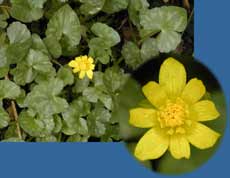

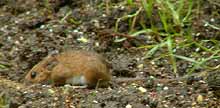


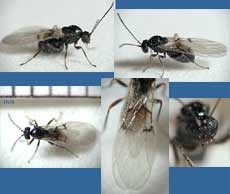

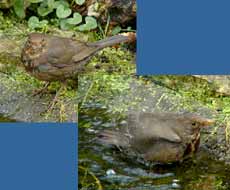
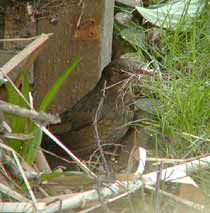
 However,
encouraging sounds and sights were recorded around 9am when a Great Tit
spent nearly ten minutes around the entrance to our BT box, looking in,
calling, and pecking at the wood. The entrance is big enough, so my fingers
are firmly crossed!
However,
encouraging sounds and sights were recorded around 9am when a Great Tit
spent nearly ten minutes around the entrance to our BT box, looking in,
calling, and pecking at the wood. The entrance is big enough, so my fingers
are firmly crossed!
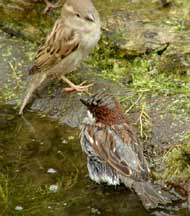
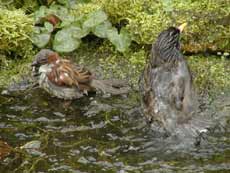
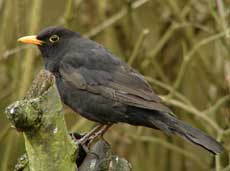
 9am
this morning brought another round of deafening tapping noises from the
birdbox as the Great Tits turned up again. During this first visit, not only
did the female enter the box, but at one stage she was fed by the male,
although he didn't enter.
9am
this morning brought another round of deafening tapping noises from the
birdbox as the Great Tits turned up again. During this first visit, not only
did the female enter the box, but at one stage she was fed by the male,
although he didn't enter. 


